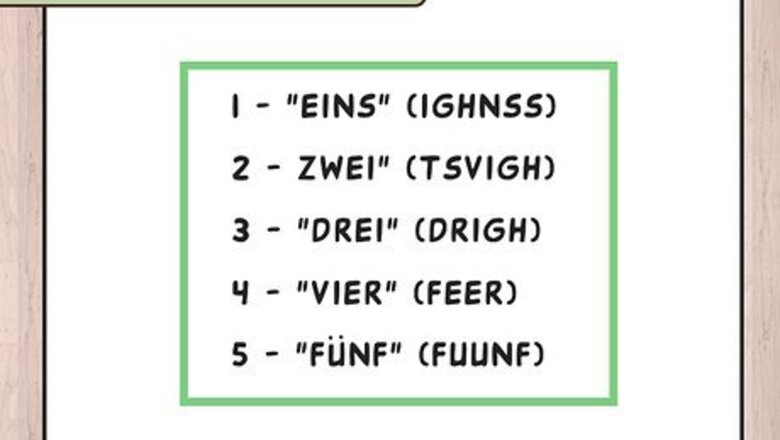
views
Counting from One to Ten
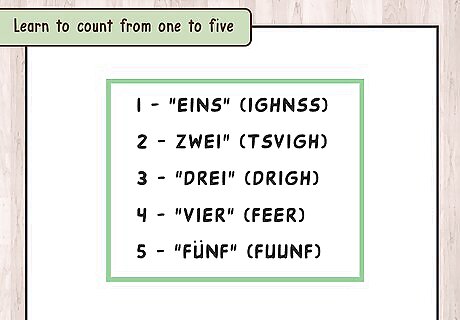
Learn to count from one to five. If you want to learn to count to 20 (and beyond) in German, the easiest way to start is to break the numbers down into smaller chunks. Learn the first five numbers first, and proceed to the next five when you have those down. Here are the first five numbers, with pronunciation in parentheses: One is "eins" (ighnss). Two is "zwei" (tsvigh). Remember to pronounce "ts" like the "tz" in the English word "quartz." Three is "drei" (drigh). Four is "vier" (feer). Five is "fünf" (fuunf). Most Germans pronounce it with more of an "m" sound than an "n" (like "fuumf") because the "mf" consonant combination is easier to pronounce than "nf." So don't feel embarrassed if you find yourself doing the same thing.

Continue counting to five repeatedly. The best way to learn to count is to count from one to five over and over again until it becomes second nature. When you count things in your daily life, count in German instead of in English. You can also write the words on cards and tape them to a mirror or a door you look at regularly. This will help solidify the letters and words in your mind.
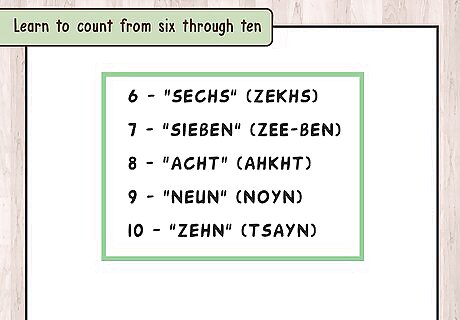
Learn to count from six through ten. Once you've mastered counting to five, you're ready to add the next five numbers to the mix. Here are numbers six through ten in German, with pronunciation in parentheses after the German word: Six is "sechs" (zekhs). The "ch" sound is a hard "k" sound, spoken from the back of your throat. Think of the noise you make when you clear your throat, or that a cat makes when it hisses. Seven is "sieben" (ZEE-ben). Capitalization of a syllable in pronunciation tells you which syllable to stress. Eight is "acht" (ahkht). Remember to say it from the back of your throat. Nine is "neun" (noyn). Ten is "zehn" (tsayn).
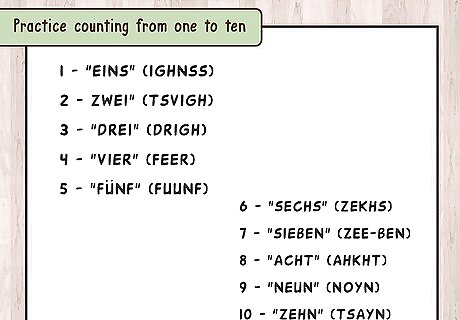
Practice counting from one to ten. You can practice six through ten for awhile first if you want, so you have them down pat as well as you memorized one to five. When you're ready, start practicing counting all the way from one to ten. You can use the same practice methods that worked for you when you practiced counting from one to five. You might also be able to find counting songs for German children on the internet. You may feel silly listening to children's music, but listening to these songs can help you learn to count in German the same way you probably learned to count in English.
Counting to Twenty and Beyond
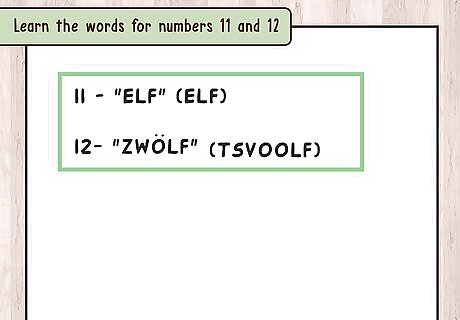
Learn the words for numbers 11 and 12. Just as in English, the numbers 11 and 12 in German are outliers – they aren't formed the way the other larger numbers are. For this reason, it's easiest to learn them separately. Eleven is "elf" (elf). Twelve is "zwölf" (tsvoolf). This is a deceptively difficult word for native English speakers to pronounce.
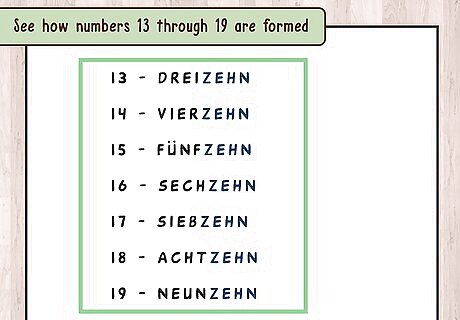
See how numbers 13 through 19 are formed. The "teens" in German are formed similarly to the way these number-words are formed in English, although English actually gets a bit more complicated. In German, all you have to do is take the word for ten, "zehn," which you already know. On the front of "zehn," put the word from one to nine that corresponds to the second digit of the number. So, for example, 13 in German is "dreizehn" (DRIGH-tsayn). Literally, you can think of it as "three and ten," which add up to 13. All the other number-words in the teens are formed the same way, with stress always on the first syllable.
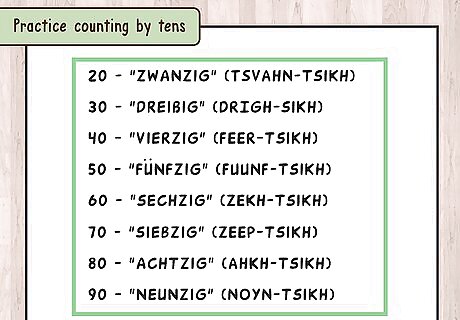
Practice counting by tens. The easiest way to learn to continue counting in German is to first memorize the words for the tens – 20, 30, 40, 50, 60, 70, 80, and 90. Many of these words are formed by adding "zig" to the word for the initial number, as you'll see: Twenty is "zwanzig" (TSVAHN-tsikh). Thirty is "dreißig" (DRIGH-sikh). The "ß," called an Eszett or scharfes S (sharp S), is a unique German letter pronounced essentially like the "s" sound in "kiss" or "bless." Forty is "vierzig" (FEER-tsikh). Fifty is "fünfzig" (FUUNF-tsikh). Sixty is "sechzig" (ZEKH-tsikh). Seventy is "siebzig" (ZEEP-tsikh). Eighty is "achtzig" (AHKH-tsikh). Ninety is "neunzig" (NOYN-tsikh).
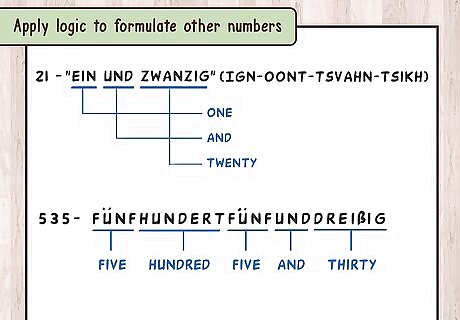
Apply logic to formulate other numbers. Once you know how to count by tens and how to count from one to nine, you have all the building blocks you need to create virtually any other number in German. Start with the smallest number, and work up from there to build the word. For example, 21 in German is "einundzwanzig" (IGN-oont-tsvahn-tsikh). A literal translation would be "one and twenty," as "und" is the German word for "and." All numbers up to a hundred are built this way, with the word for 100 being "hundert" (HOON-dert). The word literally means "hundred," so 100 is einhundert. As you can probably guess, the building starts again here, the same as it did with the lower numbers. Write (or say) the hundreds first, then the digits that follow. Keep in mind that there's no "und" or "and" between the hundred and the other digits. Since people often say "three hundred and eleven" in English to mean 311, you might be tempted to add it in. Since you know how to pronounce the building blocks, you know how to build and pronounce some lengthy words. For example, 535 in German is "fünfhundertfünfunddreißig."
Mastering Pronunciation
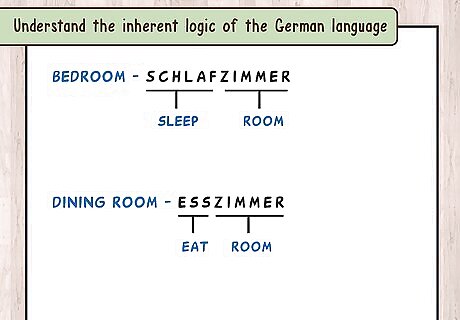
Understand the inherent logic of the German language. Unlike English or French, the German language has an inherent logic in the way words are put together. This logic can help you understand how German words are put together, as well as how they're pronounced. You can see this logic easily in the German words for rooms in a house. The word for "room" in German is "zimmer," and many German words for rooms are a combination of the word "zimmer" with the verb that you would use to describe what you did in that room. For example, the German word for "bedroom" is "Schlafzimmer." Since "schlaf" means "sleep," a literal translation would be "sleep(ing) room." Likewise, the German word for "dining room" is "Esszimmer" – "ess" meaning "eat" and "zimmer" meaning "room," literally "eat(ing) room." You will see this logic at work when you are learning to count in German.
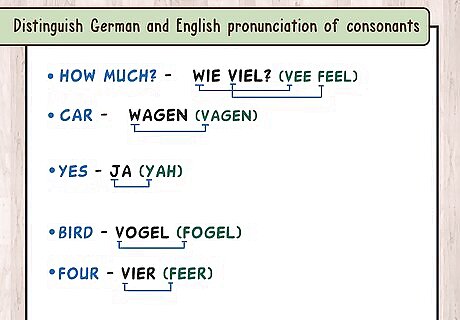
Distinguish German and English pronunciation of consonants. While most of the German letters look the same as English letters, they may be pronounced differently. If English is your first language, you must practice repeatedly to overcome your first impulse to pronounce those letters as you would in English. Pronounce "w" the way you would pronounce a "v" in English. A "v" in German is pronounced like an "f" in English. You can put those two pronunciation rules together to say a phrase related to counting. To ask "how much?" in German, you would say "Wie viel?" This question is pronounced "vee feel." A "j" in German is pronounced like a "y" – as in "ja" (yah), the German word for "yes." German also includes many consonants next to each other that may seem difficult or impossible to pronounce if you're used to speaking in English. Generally, when you see two consonants together, you want to pronounce both sounds quickly. Neither letter is silent, as is common in English. For example, if you see a "ts" together, you pronounce it much like the "tz" in the English word "quartz."
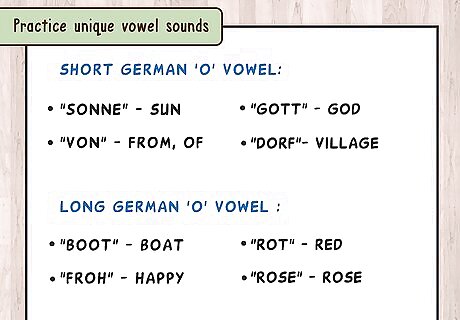
Practice unique vowel sounds. The German language has some vowel sounds that aren't present in English, or at least aren't common. These sounds can be difficult to make because they're entirely foreign both to your mouth and your ear. For example, the sound of an "ö" has no equivalent in English. It approaches the "i" sound in the word "girl," but saying it literally that way is still not quite right. You will see this sound in the German word for the number 12. Likewise, the sound of an "ü" in German has no exact equivalent in English. It's somewhat like the vowel sound in the word "due," but a little rounder than that. If you're familiar with French, think of the "u" sound in words such as "une" or "etude," which are closer to the correct sound. The only way you can get sounds like this correct is to practice words with those sounds over and over again.

Pronounce diphthongs correctly. A diphthong is a combination of two vowels that are blended together into a single sound. However, you can hear the sound of both vowels if you draw out the word. For example, the German diphthongs "eu" and "äu" are both pronounced similarly to the way "o" is pronounced in the English words "boy" or "joy." However, just because there are two vowels together in a German word does not mean they are a diphthong. Keep in mind that if you see an "e" at the end of a word, it's typically not silent. The "e" in German has a sound like "eh" or "uh." So "treue," the German word for "true," would be pronounced "troy-uh."

Listen and repeat. The best way to get your pronunciation right is to say the words over and over, as well as listen to native speakers. Search online for German videos and listen to the words. At this point, it doesn't matter that you don't understand what the words mean. You're listening to become accustomed to the sound of the German language. You also should pay attention to the way Germans move their mouths when they speak. Generally, the German language is a more tight-lipped language, with tension in the jaw. If you try to imitate this and hold your jaw more tightly, you may have an easier time getting the pronunciation right.



















Comments
0 comment